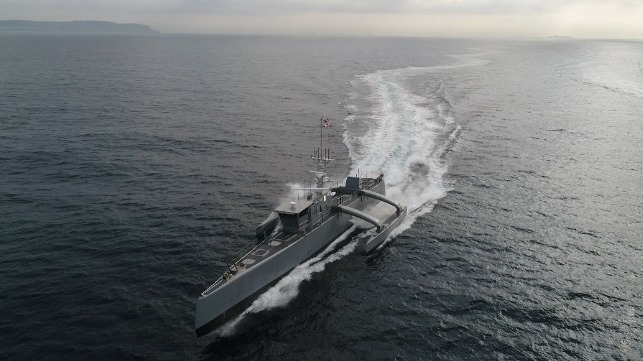US Navy's Top Officer: Manned-Unmanned Teaming is "Where We're Headed"

In a series of public appearances last week, the U.S. Navy's top officer made clear that unmanned systems are an essential part of the service's plans as it aims to grow its fleet within the confines of a limited budget.
"We believe [unmanned is] an important part of the future [and] that we can’t afford to field a Navy like we did in the previous century," Chief of Naval Operations Adm. Mike Gilday said, speaking at an online forum held by the Center for Strategic and Budgetary Assessments (CSBA). "We believe that numbers are important, but with respect to affordability, with respect to lethality, that there’s a better way to get at it than we have before. Unmanned is part of that answer. And certainly manned-unmanned teaming . . . is where we’re headed."
A big part of the reason is in budgeting. Gilday pointed out that the Navy's inflation-adjusted buying power has been more or less the same since 2010, with some temporary increases for the Ford-class aircraft carriers and (more recently) the Columbia-class nuclear missile submarine. Going forward, he said that he expects that the Navy's top line will be "lucky to actually keep pace with inflation."
The service also faces a major budgetary speed bump over the next decade. The Ohio-class nuclear missile submarines are entering their fourth decade in service, and their strategic "no-fail mission" requires a replacement. The replacement Columbia-class will consume billions of dollars in shipbuilding funding at the same time that the Navy is attempting to increase the size of its fleet.
Unmanned systems could offer a way to build far more hulls for far less money. However, there are two obstacles at present: unmanned asset reliability and remote command and control. "We don't want to have tow these things in from the middle of the Pacific," Gilday said. To get to a series of robust platforms that have these two concerns nailed down, the Navy is planning to downselect and sunset some of its 15 unmanned-systems development programs, focusing its resources on the candidates that perform best in testing.
It's not just assets on the water - it's also inventive unmanned ideas ashore. Gilday highlighted a novel idea developed by several Marine Corps officers with the truck-builder Oshkosh: a mobile, unmanned, remote-controlled anti-ship missile launch vehicle. A prototype has been built and live-fire tested. "Now we can move this around the vessels, put it onshore and hold an adversary at risk," he said.
Cost savings
To pay for the Columbia-class program and the transition to a numerically-larger, partially-manned fleet, the Navy is proposing several cost-saving measures. Gilday outlined several options in a hearing of the House Appropriations Subcommittee on Defense last week.
First, the service has proposed to decommission the first four littoral combat ships (LCS 1-4), which have not received any capability upgrades since they were sidelined for testing and training in 2016. Congress has already approved decommissioning for LCS 1 and 2, and the Navy plans to request the same fate for LCS 3 and 4.
Second, the Navy is ready to decommission some of its oldest Ticonderoga-class cruisers. Gilday pointed to the well-publicized maintenance challenges aboard USS Vella Gulf, which had to return to port for repairs several times in March and April.
Third, it has studied the potential cost savings of buying used foreign-flag commercial vessels for the purpose of recapitalizing the sealift fleet. Used foreign-built vessels in good condition could be purchased for $20-25 million, Gilday said, instead of the nine-digit cost to build new in the United States. Multiplied over the tens of vessels required to replenish the aging MARAD and MSC reserve fleets, this savings alone could help pay for new U.S.-built surface combatants or submarines.
One thing will not be cut: despite concerns about limited lethality and high operating costs, the Navy is "very bullish" about the rest of the littoral combat ship fleet. It is upgrading 31 LCS vessels with missile systems and adding long-awaited anti-submarine and anti-mine capabilities on them. The last two items - so-called mission packages - have been delayed for years, but Gilday said that they are expected to be operational within 18 months. As to the chronic problems with the combining gears on the Freedom-class LCS, the vendor is now testing a fix, and once it is ready and installed the service will resume taking deliveries.
